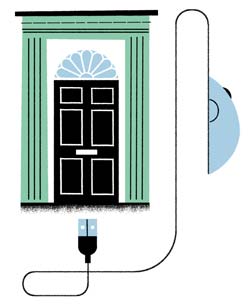By John Thornton | 1 February 2012
In 1997, Tony Blair set a target for ‘e-government’ and almost achieved it. Now, Francis Maude has picked up the mantle. So how have things changed?
 In November 2010, Cabinet Office minister Francis Maude confirmed the
government’s intention to use digital technology to drive better
services and lower costs. Together with Martha Lane Fox, the
government’s digital champion, he urged a ‘channel shift’ so that public
services would increasingly be provided ‘digitally by default’.
In November 2010, Cabinet Office minister Francis Maude confirmed the
government’s intention to use digital technology to drive better
services and lower costs. Together with Martha Lane Fox, the
government’s digital champion, he urged a ‘channel shift’ so that public
services would increasingly be provided ‘digitally by default’.
Maude and Lane Fox explained that digital services were not only more convenient and cheaper, but could also be better and more personalised. They argued persuasively that the shift towards online services also had the power to transform the relationship between government and individuals. What progress has been made more than a year on?
As we all know, the push for online services is not new. In 1997, the then prime minister Tony Blair created an expectation that government services should be available electronically by 2008. It is easy to see why this was politically important and high on the New Labour government’s agenda. This was at the height of the dot.com boom and there were deep concerns about the competitiveness of the British economy and the responsiveness of public services.
By March 2000, however, progress had been slow and most forecasters were predicting that the global impact of e-commerce would reach its peak by 2005. Blair’s response was to announce that the 2008 target was not ambitious enough. He revised it to require that all government services should be available online by 2005, backing this target with £1bn of funding.
The late 1990s was a time of bold, aspirational targets and the 2005 target was at the time considered by most informed commentators to be ‘mission impossible’.
The result was that by 2005 almost all government and local government services were available online and the UK was one of the world leaders in what was then called e-government.
While these new services were generally very clunky and connected to antiquated back-office systems, they did show what was possible and provided the impetus for much of the public service business transformation that followed.
What is different about ‘digital by default’? First, the current deficit reduction plans and workforce cuts make in even more important to make rapid progress.
In addition, the general public is now much happier using digital services. A recent Office of National Statistics report shows that 77% of households (19 million) have an internet connection and 32 million people (66% of all adults) have purchased goods or services over the internet, including 27% of those aged over 65.
Also, digital business services such as virtual meetings are now commonplace. This means that expectations for digital services must now move way beyond merely offering the public online access.
The Ministry of Justice, for example, is currently piloting virtual courts with ‘live link’ communications between police stations and magistrates courts. This technology allows police officers to give evidence remotely and has saved more than 100 hours of police time in 24 cases. The MoJ says that this not only enables quick resolution of cases but also saves time as defendants do not need to be transferred between prisons and the court.
Sir Bruce Keogh, the NHS medical director, recently announced that the NHS is drawing up plans to introduce online consultations and that IT will completely change the provision of medicine in the future.
Unfortunately, examples such as these are scarce. If the government really believes in ‘digital by default’, it needs to be bold and inspirational in its plans. It also needs to create ‘invest to save’ mechanisms to support, stimulate and fund transformational change.
John Thornton is a director of e-ssential Resources, and an independent adviser and writer on business transformation, financial management and innovation

In 1997, Tony Blair set a target for ‘e-government’ and almost achieved it. Now, Francis Maude has picked up the mantle. So how have things changed?
 In November 2010, Cabinet Office minister Francis Maude confirmed the
government’s intention to use digital technology to drive better
services and lower costs. Together with Martha Lane Fox, the
government’s digital champion, he urged a ‘channel shift’ so that public
services would increasingly be provided ‘digitally by default’.
In November 2010, Cabinet Office minister Francis Maude confirmed the
government’s intention to use digital technology to drive better
services and lower costs. Together with Martha Lane Fox, the
government’s digital champion, he urged a ‘channel shift’ so that public
services would increasingly be provided ‘digitally by default’. Maude and Lane Fox explained that digital services were not only more convenient and cheaper, but could also be better and more personalised. They argued persuasively that the shift towards online services also had the power to transform the relationship between government and individuals. What progress has been made more than a year on?
As we all know, the push for online services is not new. In 1997, the then prime minister Tony Blair created an expectation that government services should be available electronically by 2008. It is easy to see why this was politically important and high on the New Labour government’s agenda. This was at the height of the dot.com boom and there were deep concerns about the competitiveness of the British economy and the responsiveness of public services.
By March 2000, however, progress had been slow and most forecasters were predicting that the global impact of e-commerce would reach its peak by 2005. Blair’s response was to announce that the 2008 target was not ambitious enough. He revised it to require that all government services should be available online by 2005, backing this target with £1bn of funding.
The late 1990s was a time of bold, aspirational targets and the 2005 target was at the time considered by most informed commentators to be ‘mission impossible’.
The result was that by 2005 almost all government and local government services were available online and the UK was one of the world leaders in what was then called e-government.
While these new services were generally very clunky and connected to antiquated back-office systems, they did show what was possible and provided the impetus for much of the public service business transformation that followed.
What is different about ‘digital by default’? First, the current deficit reduction plans and workforce cuts make in even more important to make rapid progress.
In addition, the general public is now much happier using digital services. A recent Office of National Statistics report shows that 77% of households (19 million) have an internet connection and 32 million people (66% of all adults) have purchased goods or services over the internet, including 27% of those aged over 65.
Also, digital business services such as virtual meetings are now commonplace. This means that expectations for digital services must now move way beyond merely offering the public online access.
The Ministry of Justice, for example, is currently piloting virtual courts with ‘live link’ communications between police stations and magistrates courts. This technology allows police officers to give evidence remotely and has saved more than 100 hours of police time in 24 cases. The MoJ says that this not only enables quick resolution of cases but also saves time as defendants do not need to be transferred between prisons and the court.
Sir Bruce Keogh, the NHS medical director, recently announced that the NHS is drawing up plans to introduce online consultations and that IT will completely change the provision of medicine in the future.
Unfortunately, examples such as these are scarce. If the government really believes in ‘digital by default’, it needs to be bold and inspirational in its plans. It also needs to create ‘invest to save’ mechanisms to support, stimulate and fund transformational change.
John Thornton is a director of e-ssential Resources, and an independent adviser and writer on business transformation, financial management and innovation


















